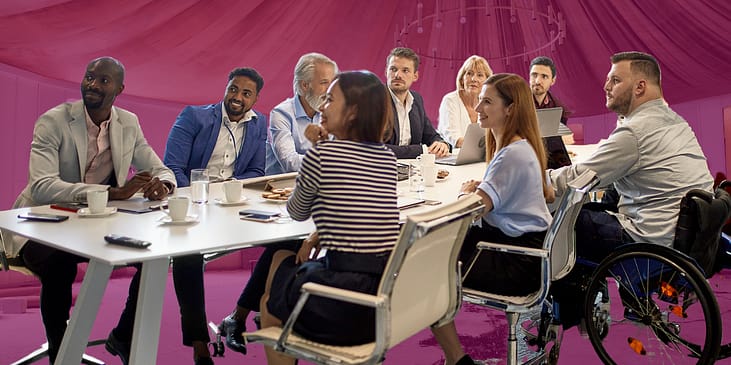By Tiffany Yu, CEO & Founder at Diversability & Arielle Dance, Writer at Diversability
As in-person conferences, gatherings, and events are making their return, it is imperative that the comfort and safety of participants and attendees are considered. With heightened awareness of diversity, equity, and inclusion (DEI), accessibility needs should be centered in those considerations. From religious gatherings, fundraisers, tech conventions, to formal galas, disabled attendees should be able to access the event organizer’s programming.
How to implement change in your company or organization
Some companies and organizations have hosted large-scale events for decades and have maintained their run-of-show to perfection. It took a pandemic for us to realize that all of us could make virtual events possible. While incorporating accommodations like a sign language interpreter or a wheelchair-accessible venue might seem like a learning curve, implementing these access improvements will open up your event to new audiences and communities. One suggestion, is that you could start by adding a line for accessibility improvements in your event budget.
For some companies or organizations, leaning on your DEI staff or Employee Resource Groups (also known as affinity groups) may be necessary. Within the DEI or human resources space, disability resources can be made available to all staff in a company to make a strong stance on the necessity of inclusion of any given group. The DEI department or resource group also has some autonomy to create company-wide guidance on best practices for implementing accessibility at events.
WID also offers Conference and Event Accessibility Services and resources, which can help your organization determine the most inclusive and accessible needs for your in-person or virtual gatherings.
Here are 11 Tips To Consider for Your Event
1. Include access information on the registration form
Ask the participants of your event how you can make them more comfortable on the days they are with you. In your registration form or RSVP, offer an open response or list some of the suggestions from above (American Sign Language interpreters, wheelchair-accessible, etc.) that guests can choose from. Always include a write-in option, because your attendees may have needs you did not expect. Event registration forms should also be digitally accessible.
2. Accessible venues, restrooms, and seating
Venues
For most modern venues, physical accessibility in the built environment is a non-issue as it is mandated by law. However, for older venues, imagine the path from various perspectives by asking yourself, “Would someone in a wheelchair be able to access the main ballroom from the parking lot?” At that moment you may notice that there are no ramps or elevators available. In addition, Katherine Lewis, an accessibility consultant and business strategist, suggests “making it easy to find elevators, ramps, etc. Sometimes they’re not marked and [are] incredibly difficult to find.” Pay attention to moveable elements like the placement of tables and chairs – if they are too close together, a wheelchair user or Blind person may not be able to move through the space, and people who use canes and crutches may also struggle to squeeze past these obstacles. For large events, consider having a mobility device (such as scooters, wheelchairs or walkers) on site. Sighted guide services are also strongly recommended.
Restrooms
For indoor and outdoor events, having plenty of restrooms and spacious restrooms is a necessity. One of the most disrespectful, uncomfortable, and embarrassing experiences a disabled person can face at an event is not being able to access the restroom. For outdoor events, be sure to request accessible portable toilets. As mentioned, for your indoor venue selection, remember that some older venues may not have larger stalls in restrooms. When you go on a site visit, remember to visit the restrooms.
Seating
Nidhi Jaisoor, a disability advocate and short fiction writer, often carries a cushion with her to help support her back. She adds that a variety of seating options contributes to accessibility: “with armrests and without, wide, high-backed if possible, lower [to] the ground… I once went to a meditation class where they were super accommodating when I told them I had back issues and said they’d get a computer chair from their office for me to sit on as opposed to having to sit on the floor or those plastic folding chairs that cause me so much grief.”
3. Sign language interpreters and captioning
Whether online or in-person, event organizers have multiple options to provide clear communication of presenters and content. Sign language interpreters can be hired for live events or virtual presentations. You can also hire a CART (Communication Access Realtime Translation) captioner for accurate real-time captioning. We’ve used Interpreter Now and White Coat Captioning for Diversability’s events in the past, and WID has more providers on their Recommended Service Providers list, located on their Conference Accessibility Resources page. While it is approximately 20 percent less accurate than CART, auto-captioning and transcription are available on most virtual platforms.
4. Signage & text resources in a variety of formats (braille, large print, plain text)
Signage at any event is imperative as it sets a tone for clear communication and logistics. Logistics signs (specifically directional and room assignments) should embrace the Braille system. Though many events have steered away from paper and become more digital facing in a post-pandemic world, when hard copies are available, large print options should be made available. If your event is using an app for sharing conference information, make sure it has been UX or user experience-tested with people with disabilities.
Nico Meyering, a disabled advocate and AmeriCorps alum, adds, “disabled people with cognitive concerns may appreciate the material in plain language.”
5. Breaks
For disabled people living in chronic pain or who require intermittent medication or bio-breaks, having regularly scheduled breaks in your event schedule is so important. These built-in breaks are especially helpful for virtual events that tend to pack their schedules hour to hour even through meals.
6. Quiet room and sensory considerations
Another consideration that may benefit all attendees is a quiet space to center when they are overstimulated or an opportunity to offer a space for meditation. Amber Brown, a spiritual writer and outdoor adventurer, appreciates “a quiet space to relax until my symptoms subside”.
For attendees with sensory sensitivities or auditory disabilities, organizers should be mindful of the group spaces and technology that is utilized. Some participants may need to avoid large groups or may need to wear earplugs to adapt to the group setting. Accommodations should also be considered for participants who may not be able to wear virtual reality headsets that are provided.
7. Ability to bring service animals
No, we are not inviting pets to your event (unless that is what you want). We are suggesting that you are aligned with the Americans with Disabilities Act (or your country’s equivalent) and allow people with disabilities to have their service animals with them. Have conversations with your venues that participants may need accommodations for service animals so they are not surprised. Accommodations for service animals include a place for the animals to relieve themselves, and training for event or venue staff to be able to recognize a service animal and to avoid distracting or distressing the animals.
8. Having medical staff on-site
For some events, having your local emergency medical services (EMS) on-site seems standard, in other cases, it could feel like an added expense. Consider welcoming your first responders as guests or requesting their services as a possible sponsorship opportunity and adding their logo to your materials. Their presence would benefit all guests but provide a layer of safety in case of any emergencies or health crises.
9. Reserved parking
This may seem self-explanatory, but having enough reserved parking for disabled guests is necessary. For some event spaces, like an outdoor field, there may not be designated accessible parking spaces. Therefore, event staff may need to intentionally designate these spaces during event set-up. Additionally, reminding your venue, vendors, staff, and volunteers not to use these close-to-door parking spaces for loading and unloading is essential.
10. Hybrid options
We know how convenient virtual options are but we miss the fellowship and energy of group gatherings. Consider a hybrid model (a mix of in-person and virtual) to accommodate participants who prefer the comfort of home or attending in person is not accessible for them while still welcoming those who are ready to return to in-person environments.
11. Mask requirements
Mask requirements will make it possible for many disabled people, especially those who are immunocompromised, to attend your in-person events. While there is no way to eliminate the risk of COVID infections, you can minimize the risks by requiring participants to wear face masks, and holding your event outside when possible. Not all disabled people are able to wear masks, but by having the majority of attendees mask, everyone can help protect each other. Vaccination and testing requirements are also helpful, but as the variants continue to mutate, masks and outdoor events are the best protection we can offer.
What would you add? For more suggestions, check out the WID’s Accessibility Solutions and Universal Design Services.

Tiffany Yu is a Blog Contributor at WID.


1 comment on “Making Your Events More Accessible”